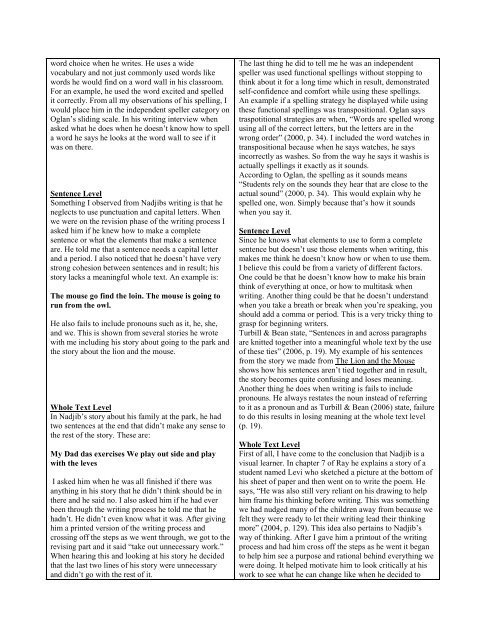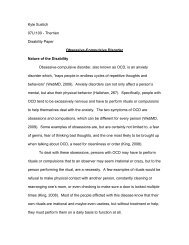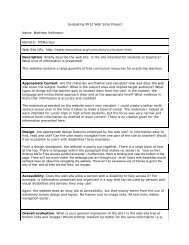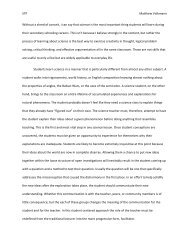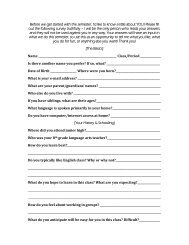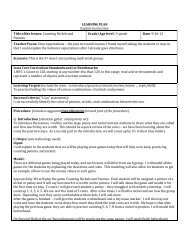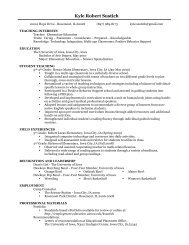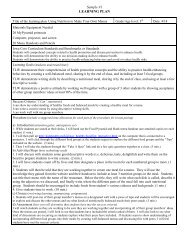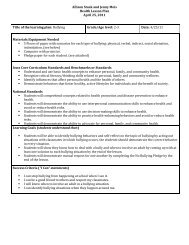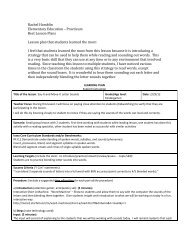Writing child study - Employment
Writing child study - Employment
Writing child study - Employment
You also want an ePaper? Increase the reach of your titles
YUMPU automatically turns print PDFs into web optimized ePapers that Google loves.
word choice when he writes. He uses a wide<br />
vocabulary and not just commonly used words like<br />
words he would find on a word wall in his classroom.<br />
For an example, he used the word excited and spelled<br />
it correctly. From all my observations of his spelling, I<br />
would place him in the independent speller category on<br />
Oglan’s sliding scale. In his writing interview when<br />
asked what he does when he doesn’t know how to spell<br />
a word he says he looks at the word wall to see if it<br />
was on there.<br />
Sentence Level<br />
Something I observed from Nadjibs writing is that he<br />
neglects to use punctuation and capital letters. When<br />
we were on the revision phase of the writing process I<br />
asked him if he knew how to make a complete<br />
sentence or what the elements that make a sentence<br />
are. He told me that a sentence needs a capital letter<br />
and a period. I also noticed that he doesn’t have very<br />
strong cohesion between sentences and in result; his<br />
story lacks a meaningful whole text. An example is:<br />
The mouse go find the loin. The mouse is going to<br />
run from the owl.<br />
He also fails to include pronouns such as it, he, she,<br />
and we. This is shown from several stories he wrote<br />
with me including his story about going to the park and<br />
the story about the lion and the mouse.<br />
Whole Text Level<br />
In Nadjib’s story about his family at the park, he had<br />
two sentences at the end that didn’t make any sense to<br />
the rest of the story. These are:<br />
My Dad das exercises We play out side and play<br />
with the leves<br />
I asked him when he was all finished if there was<br />
anything in his story that he didn’t think should be in<br />
there and he said no. I also asked him if he had ever<br />
been through the writing process he told me that he<br />
hadn’t. He didn’t even know what it was. After giving<br />
him a printed version of the writing process and<br />
crossing off the steps as we went through, we got to the<br />
revising part and it said “take out unnecessary work.”<br />
When hearing this and looking at his story he decided<br />
that the last two lines of his story were unnecessary<br />
and didn’t go with the rest of it.<br />
The last thing he did to tell me he was an independent<br />
speller was used functional spellings without stopping to<br />
think about it for a long time which in result, demonstrated<br />
self-confidence and comfort while using these spellings.<br />
An example if a spelling strategy he displayed while using<br />
these functional spellings was transpositional. Oglan says<br />
traspotitional strategies are when, “Words are spelled wrong<br />
using all of the correct letters, but the letters are in the<br />
wrong order” (2000, p. 34). I included the word watches in<br />
transpositional because when he says watches, he says<br />
incorrectly as washes. So from the way he says it washis is<br />
actually spellings it exactly as it sounds.<br />
According to Oglan, the spelling as it sounds means<br />
“Students rely on the sounds they hear that are close to the<br />
actual sound” (2000, p. 34). This would explain why he<br />
spelled one, won. Simply because that’s how it sounds<br />
when you say it.<br />
Sentence Level<br />
Since he knows what elements to use to form a complete<br />
sentence but doesn’t use those elements when writing, this<br />
makes me think he doesn’t know how or when to use them.<br />
I believe this could be from a variety of different factors.<br />
One could be that he doesn’t know how to make his brain<br />
think of everything at once, or how to multitask when<br />
writing. Another thing could be that he doesn’t understand<br />
when you take a breath or break when you’re speaking, you<br />
should add a comma or period. This is a very tricky thing to<br />
grasp for beginning writers.<br />
Turbill & Bean state, “Sentences in and across paragraphs<br />
are knitted together into a meaningful whole text by the use<br />
of these ties” (2006, p. 19). My example of his sentences<br />
from the story we made from The Lion and the Mouse<br />
shows how his sentences aren’t tied together and in result,<br />
the story becomes quite confusing and loses meaning.<br />
Another thing he does when writing is fails to include<br />
pronouns. He always restates the noun instead of referring<br />
to it as a pronoun and as Turbill & Bean (2006) state, failure<br />
to do this results in losing meaning at the whole text level<br />
(p. 19).<br />
Whole Text Level<br />
First of all, I have come to the conclusion that Nadjib is a<br />
visual learner. In chapter 7 of Ray he explains a story of a<br />
student named Levi who sketched a picture at the bottom of<br />
his sheet of paper and then went on to write the poem. He<br />
says, “He was also still very reliant on his drawing to help<br />
him frame his thinking before writing. This was something<br />
we had nudged many of the <strong>child</strong>ren away from because we<br />
felt they were ready to let their writing lead their thinking<br />
more” (2004, p. 129). This idea also pertains to Nadjib’s<br />
way of thinking. After I gave him a printout of the writing<br />
process and had him cross off the steps as he went it began<br />
to help him see a purpose and rational behind everything we<br />
were doing. It helped motivate him to look critically at his<br />
work to see what he can change like when he decided to


